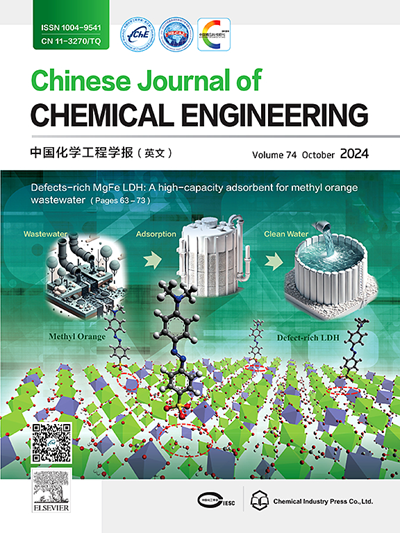温和条件下Amberlyst-15介导的氨硼烷水解的高效析氢
IF 3.7
3区 工程技术
Q2 ENGINEERING, CHEMICAL
引用次数: 0
摘要
高效、经济地实现氨硼烷(AB)水解脱氢储氢是至关重要的。本研究考察了固体酸Amberlyst-15 (A-15)在AB水解过程中析氢的作用。值得注意的是,在30℃下,AB的析氢速率可达194.15 ml·min−1,表观活化能较低,为8.20 kJ·mol−1。经过5次循环再利用,含a -15的反应仍能保持93%左右的转化率。AB水解的准一级动力学与AB浓度有关,准零级动力学与A-15质量有关。XRD、ATR-FTIR和原位质谱表征结果表明,硼酸是该反应的主要水解产物,而水是该反应的氢供体。此外,基于a -15与AB之间的氢键(aq)促进AB的扩散、H2的释放和H2O的O-H键的断裂的推理,提出了可能的机理。本文章由计算机程序翻译,如有差异,请以英文原文为准。

Efficient hydrogen evolution from Amberlyst-15 mediated hydrolysis of ammonia borane under mild conditions
The efficient and cost-effective implementation of ammonia borane (AB) hydrolysis dehydrogenation for hydrogen storage is crucial. This study investigated the role of solid acid Amberlyst-15 (A-15) for hydrogen evolution from AB hydrolysis. Notably, AB hydrogen evolution rate can reach 194.15 ml·min−1 at 30 °C, with a low apparent activation energy of 8.20 kJ·mol−1. After five cycles of reuse, the reaction involving A-15 could keep a conversion rate of about 93%. The AB hydrolysis follows quasi first-order kinetics with respect to the AB concentration and quasi zero-order kinetics with respect to the A-15 mass. According to the characterization results of XRD, ATR-FTIR, and in-situ MS, the boric acid was the dominant hydrolyzate, while water as a hydrogen donor in this reaction. Furthermore, based on the reasoning that hydrogen bonds between A-15 and AB (aq) promotes the diffusion of AB, release of H2 and the cleavage of O—H bond of H2O, a possible mechanism was proposed.
求助全文
通过发布文献求助,成功后即可免费获取论文全文。
去求助
来源期刊

Chinese Journal of Chemical Engineering
工程技术-工程:化工
CiteScore
6.60
自引率
5.30%
发文量
4309
审稿时长
31 days
期刊介绍:
The Chinese Journal of Chemical Engineering (Monthly, started in 1982) is the official journal of the Chemical Industry and Engineering Society of China and published by the Chemical Industry Press Co. Ltd. The aim of the journal is to develop the international exchange of scientific and technical information in the field of chemical engineering. It publishes original research papers that cover the major advancements and achievements in chemical engineering in China as well as some articles from overseas contributors.
The topics of journal include chemical engineering, chemical technology, biochemical engineering, energy and environmental engineering and other relevant fields. Papers are published on the basis of their relevance to theoretical research, practical application or potential uses in the industry as Research Papers, Communications, Reviews and Perspectives. Prominent domestic and overseas chemical experts and scholars have been invited to form an International Advisory Board and the Editorial Committee. It enjoys recognition among Chinese academia and industry as a reliable source of information of what is going on in chemical engineering research, both domestic and abroad.
 求助内容:
求助内容: 应助结果提醒方式:
应助结果提醒方式:


